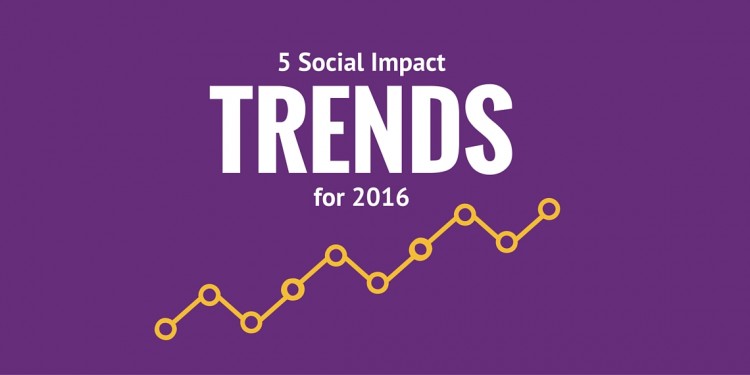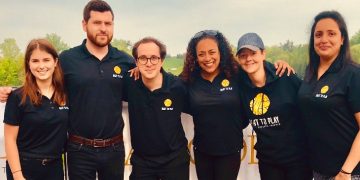5 social impact trends for 2016
The social impact sector will be an exciting field to be a part of in 2016. What started as a small niche has grown steadily and we anticipate that this movement towards meaningful work will continue to thrive in 2016. Whether you are looking to excel in your career, impress your boss or lead your company to greater impact, it’s important to not only be on top of what’s happening now but to anticipate what the future may bring.
Here are 5 upcoming trends and opportunities to look for and capitalize on in 2016:
1. Collaboration to achieve greater impact.
In 2016 we believe we will see more collaborations between and among organizations. Whether it is between companies in the same industry or across different sectors (eg. government, nonprofit and corporate), we believe the future of impact will be achieved through mutually beneficial partnerships working towards solving the same problem. We predict “co-opetition” will become more prevalent this year- a blend of cooperation and competition. Meaning, companies and organizations may work together but still compete with each other.
I believe that partnerships are the way forward for non-profit organizations that are trying to solve complex problems. Working together and mobilizing a variety of skills, expertise and resources is, in my opinion, the quickest, most effective avenue to turning the corner for communities struggling to achieve good outcomes for their constituents.- Robert Witchel, Executive Director, Jays Care Foundation
For me it would be the emerging practice of collective impact. That is to say opportunities for different sectors and stakeholders to come together to develop shared goals, strategies and solutions for complex social issues. We have just launched a new stream for this work, hoping to encourage businesses, governments and the public benefit sector to be able to effect long term system change and demonstrate results. – Andrea Cohen Barrack, CEO, OTF
One of the biggest opportunities is collaboration among companies. Through collaboration, employees of different companies can work side by side to share their expertise and accelerate solving social issues. Google is a founding member of Impact 2030 which is an initiative to leverage employee talent to solve the UN Sustainable Development Goals. I imagine a world where we can, in many cases, put aside our competitiveness for the greater good. I’m excited to see this starting to happen in a concerted way.- Diane Solinger, Manager GooglersGive, Google
2. CSR as a must-have rather than a nice-to-do.
Doing well and doing good have traditionally been viewed as two separate objectives, often resulting in CSR being siloed or a nice-to-have within a company. In 2016, we believe more companies will be embracing CSR as a must-have but that CSR will be tied to business objectives. Nonprofits and CSR leaders within organizations have the opportunity to capitalize on this desire to make a difference- thereby integrating CSR more holistically throughout the company resulting in greater impact.
The biggest opportunity is to align community investment initiatives in direct support of business values. And once that’s completed – and that’s not an easy process – companies need to stand for something big. A brand point of view helps align everyone to a common purpose that ladders up to the overall business purpose. – Lisa Gibbs, Director Community Investment, Shopper’s Drug Mart
I think the biggest opportunity in the nonprofit sector is creating customized partnership opportunities to meet the evolving needs of corporations. The corporate social responsibility movement is changing the way corporations are doing business and they are looking deeper engagement than simply writing a cheque. Whether it is leveraging your brand to create a meaningful cause marketing campaign or an engaging activation at an event, there are no limits to the partnerships you can build if you think outside the box.- Marijke Vandergrift, Associate, Sponsorship and Cause Marketing, Sick Kids Foundation.
3. Measuring and communicating your impact will take on greater importance.
Now that CSR has become more integrated within every business, the key will be how to measure (and then communicate) the results. Measurement and evaluation have always been a part of nonprofits’ modus operandi but 2016 will be about further refining the process and figuring out how to communicate the impact. Organizations that can master both will position themselves well for success with consumers both in the for-profit and nonprofit sectors.
Organizations that are starting to figure out how to measure and demonstrate impact are going to be real game changers in the social sector over the next little while. The ability to demonstrate how a program or intervention is impacting the well-being of an individual, group or even whole community over a period of time will open the doors to some exciting new funding and program delivery models. – Valery Navarrete. Senior Manager, Office of the President and CEO. YMCA of Greater Toronto
From a technical perspective, we are seeing a greater focus on measurement and evidence-based practices to inform social programming, and partnerships and integration to better serve clients. – Alexandra Snelgrove. Director, Social Impact. LIFT Philanthropy Partners
4. Adapting to the new workforce and donor base of Millennials.
2015 was the first year Millennials outnumbered Boomers in the workforce. As the demographic shift continues in 2016, Millennials’ needs will take on increased importance both from an employee and donor perspective. With an increasing desire for meaningful work companies and nonprofits will be competing for talent- the organizations that can best articulate their impact and values will be the most successful. And nonprofits and foundations that can adapt their donor strategies will similarly thrive.
The biggest opportunity is leveraging the interest of Millennials to be involved in the sector. That doesn’t mean they will instantly become massive cheque writers. But far too often in the sector were focusing on the Millennials’ parents because they happen to be the ones right now that can afford to contribute to our immediate campaign needs. That approach misses the big picture, and the large number of Millennials in entry level roles who are more impact minded than their parents’ generation. This is the first generation that had to do volunteering before they could graduate high school. Those same people are still looking to contribute to causes after high school. The most successful foundations ten years from now will be the ones that figure out how to engage Millennials now, who will then propel those organizations to unimaginable heights in the future.- Mike Bartlett. Senior Director, Corporate Responsibility, MLSE & Executive Director, MLSE Foundation
5. Finding your unique voice to be relevant.
There has never been more of an opportunity to stand out and communicate your impact. But breaking through the clutter of messaging and advertising has likewise, never been so hard. The key in 2016 will be finding your authentic voice and brand story that engages your relevant audience.
The world is a big place and we have never had the ability to reach people in so many different ways. Those who find a way to be part of the conversation will be successful and the biggest opportunity right now is to find a voice in the conversation. – Corey Evans. Manager, Sponsorship, Community Investment & Experiential Marketing. WestJet
What other trends are you seeing? Let us know in the comments below.
editors note: The quotes from industry insiders are from our previous interviews answering the question “what can you identify as the biggest opportunity in your sector”.









No Comment